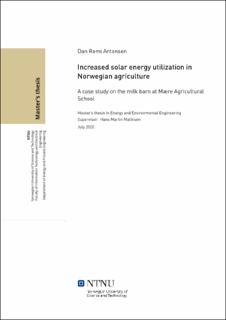| dc.contributor.advisor | Mathisen, Hans Martin | |
| dc.contributor.author | Antonsen, Dan Remi | |
| dc.date.accessioned | 2021-09-20T16:53:18Z | |
| dc.date.available | 2021-09-20T16:53:18Z | |
| dc.date.issued | 2020 | |
| dc.identifier | no.ntnu:inspera:57318108:20911481 | |
| dc.identifier.uri | https://hdl.handle.net/11250/2779660 | |
| dc.description.abstract | Dette studiets hovedmål er å utforske potensialet en økt utnyttelse av solenergi vil kunne ha for reduksjon i klimagassutslipp relatert til strømforbruk i norsk landbruk. For å kunne undersøke dette potensialet er det designet flere solcelleløsninger og solvarmeanlegg for et melkefjøs lokalisert ved Mære landbruksskole i Trøndelag fylke. Systemene er deretter gjenskapt i en programvare for simulering av resultater knyttet til løsningene. Den potensielle reduksjonen i forbruket av kjøpt elektrisitet er deretter multiplisert med flere forskjellige utslippsfaktorer for å estimere den mulige nedgangen i klimagassutslipp.
Etter at systemløsningene er gjenskapt i simuleringsprogramvaren Polysun, er resultatene fra de forskjellige modellene sammenlignet med hverandre basert på et sett med forhåndsbestemte indikatorer for systemytelse. I tillegg er det utført en kort parametrisk studie av både solcelle- og solvarmeanleggene. Resultatene fra studien antyder at solcelleanleggene er følsomme for antagelser rundt helningsvinkelen og antatte energitap, mens resultatene fra solvarmeanleggene er sterkt påvirket av rørdimensjonene i solkretsen, helningsvinkelen til solfangerne og kompleksiteten i systemoppsettet.
Solcelleanleggene er designet for å dekke omtrent 30 % av det årlige strømforbruket, men den endelige dekningsgraden på sitt høyeste ble 26,9 % (53 831,9 kWh). Av de ulike foreslåtte systemløsningene er det mest effektive solcelleanlegget i stand til å redusere klimagassutslippene fra 997 til 13 091,4 kg CO2-ekvivalenter, avhengig av den gjeldende utslippsfaktoren til elektrisitetsblandingen. Selv om det opprinnelig ikke var gode løsninger for solvarmeanleggene, ble de i stand til å redusere strømforbruket til varmtvannsanlegget i fjøset etter at resultatene fra den parametriske studien ble brukt for å optimalisere systemløsningene. De nye solvarmeanleggene resulterte i en reduksjon i strømforbruket fra 1 113 til 3 123 kWh, noe som tilsvarer fra 21 til 759,5 kg CO2-ekvivalenter. Bare ett av solvarmeanleggene klarte å oppnå den planlagte soldekningsgraden på 50 %.
Sett i en større nasjonal sammenheng med utgangspunkt i de totalt 7 600 melkegårdene i Norge, hadde disse installert både det beste foreslåtte solcelleanlegget og solvarmeanlegget, ville det i beste fall være mulig å redusere dagens klimagassutslipp relatert til strømforbruk i norsk landbruk med om lag 105 266 tonn CO2-ekvivalenter. Dette utgjør i så fall ¼ av utslippene fra strømbruk i jordbruk, skogbruk og fiskeri i Norge i 2017. | |
| dc.description.abstract | This study's main objective is to study the potential an increased utilization of solar energy could have on greenhouse gas emissions related to electricity consumption in Norwegian agriculture. To be able to investigate this potential, several photovoltaic system solutions and solar water-heating system solutions were designed for an existing milk barn located at Mære Agricultural School in Trøndelag-county. The solutions are then recreated in a simulation software. The potential reduction in consumed imported electricity is then multiplied with several different emission factors to estimate the possible decline in greenhouse gas emissions.
After the system solutions are created in the simulation software Polysun, the results from the different models are compared against each other based on a set of predetermined indicators for system performance. Also, a short parametric study is performed on both the photovoltaic system solutions and the solar water-heating systems. The results from the study indicate that the photovoltaic systems are sensitive towards assumptions made on factors such as the inclination angle and potential energy losses, while the results from the solar water-heating systems were strongly affected by the pipe dimensions in the solar circuit, inclination angle of the solar collectors and the complexity of the system layout.
The photovoltaic system solutions are designed to cover about 30 % of the annual electricity consumption, but the resulting coverage ratio was at highest 26.9 % (53 831.9 kWh). Based on the proposed system solutions, the most competent photovoltaic system is able to reduce the amount of greenhouse gas emissions somewhere between 997 to 13 091.4 kg CO2 equivalents, depending on the emission factors of the currently used electricity mix. The solar water-heating systems, though not initially efficient solutions, became capable enough to reduce the electricity consumption of the hot water system in the barn after the results from the parametric study was used to optimize the system solutions. These new solar water-heating systems resulted in a reduction in electricity consumption by 1 113 to 3 123 kWh, which is equal to about 21 to 759.5 kg CO2 equivalents. The simulation results shows that only one of the system solutions are able to reach the planned solar fraction of 50 %.
In conclusion, if all 7 600 milk farms in Norway choose to implement both the best case photovoltaic system solution and solar water-heating system solution, it might reduce the current greenhouse gas emissions related to electricity consumption in Norwegian agriculture around 105 266 tons of CO2 equivalents, similar to ¼ of the emissions from electricity usage in agriculture, forestry and fisheries in 2017. | |
| dc.language | | |
| dc.publisher | NTNU | |
| dc.title | Increased solar energy utilization in Norwegian agriculture | |
| dc.type | Master thesis | |
